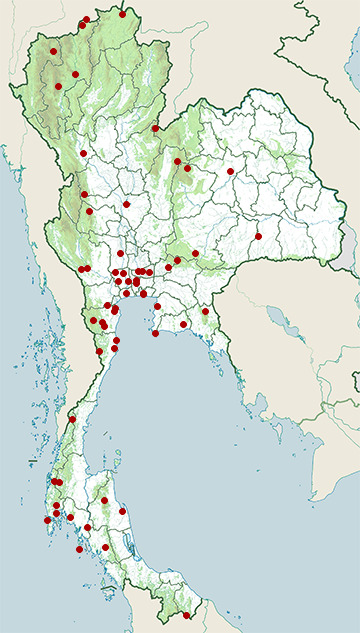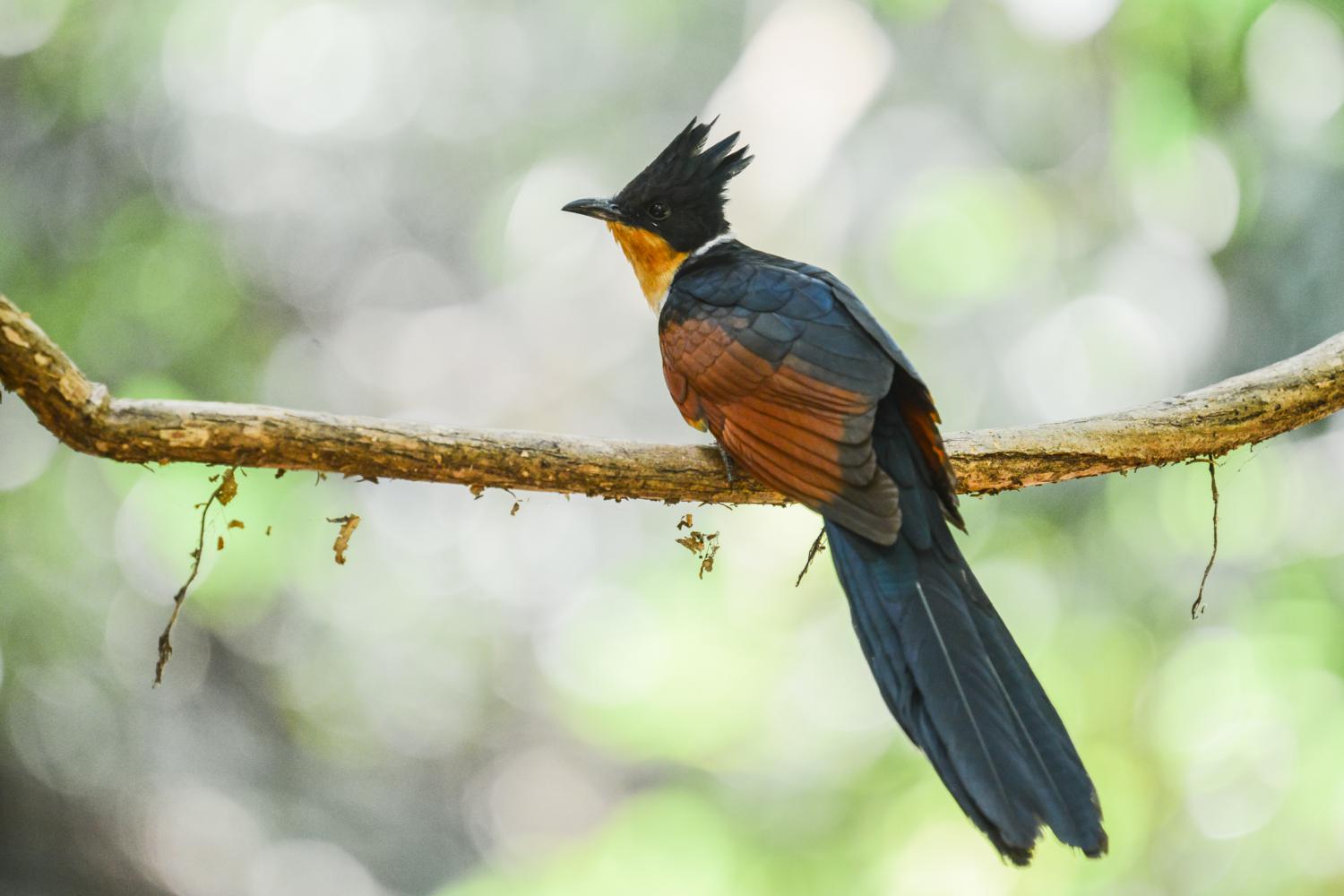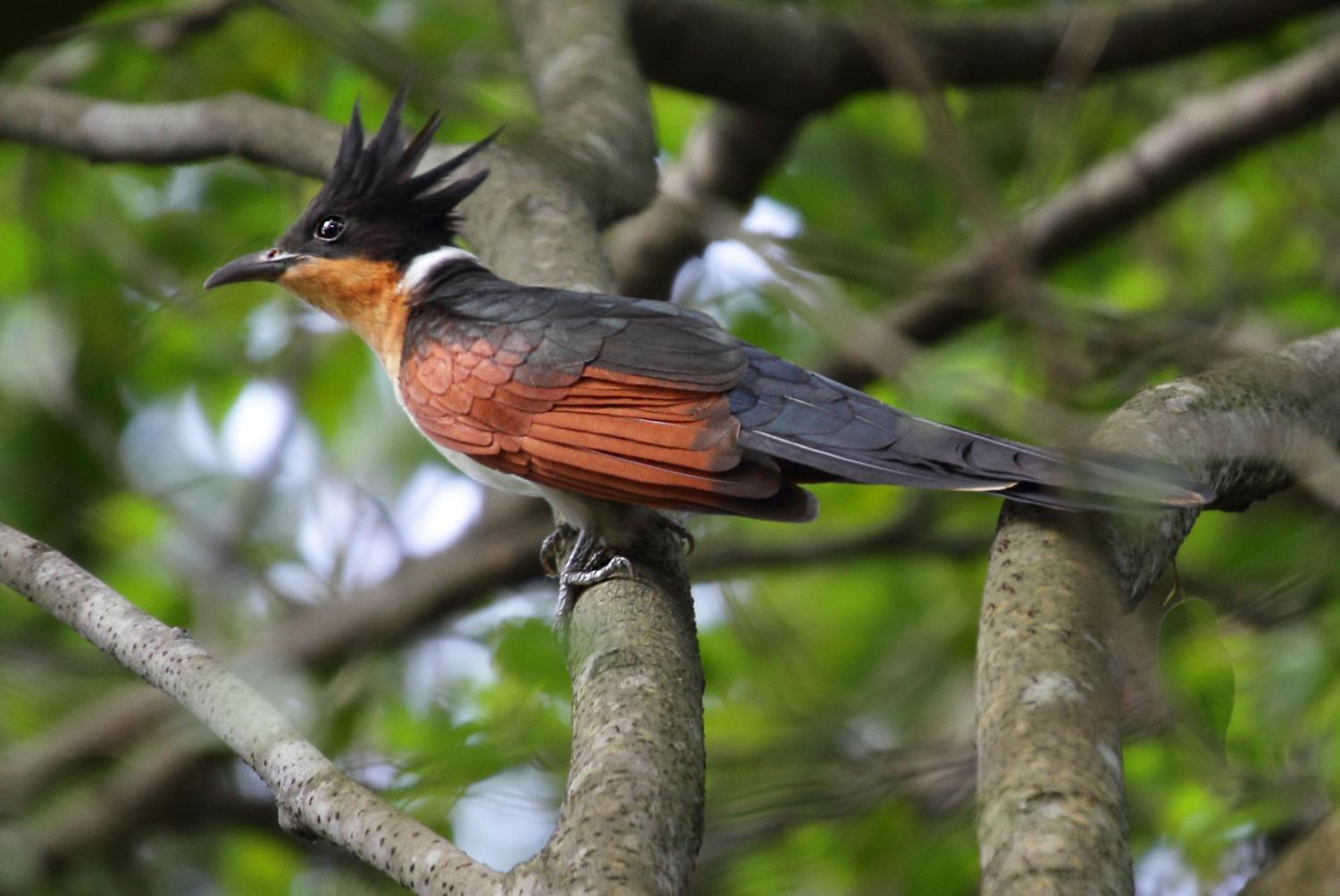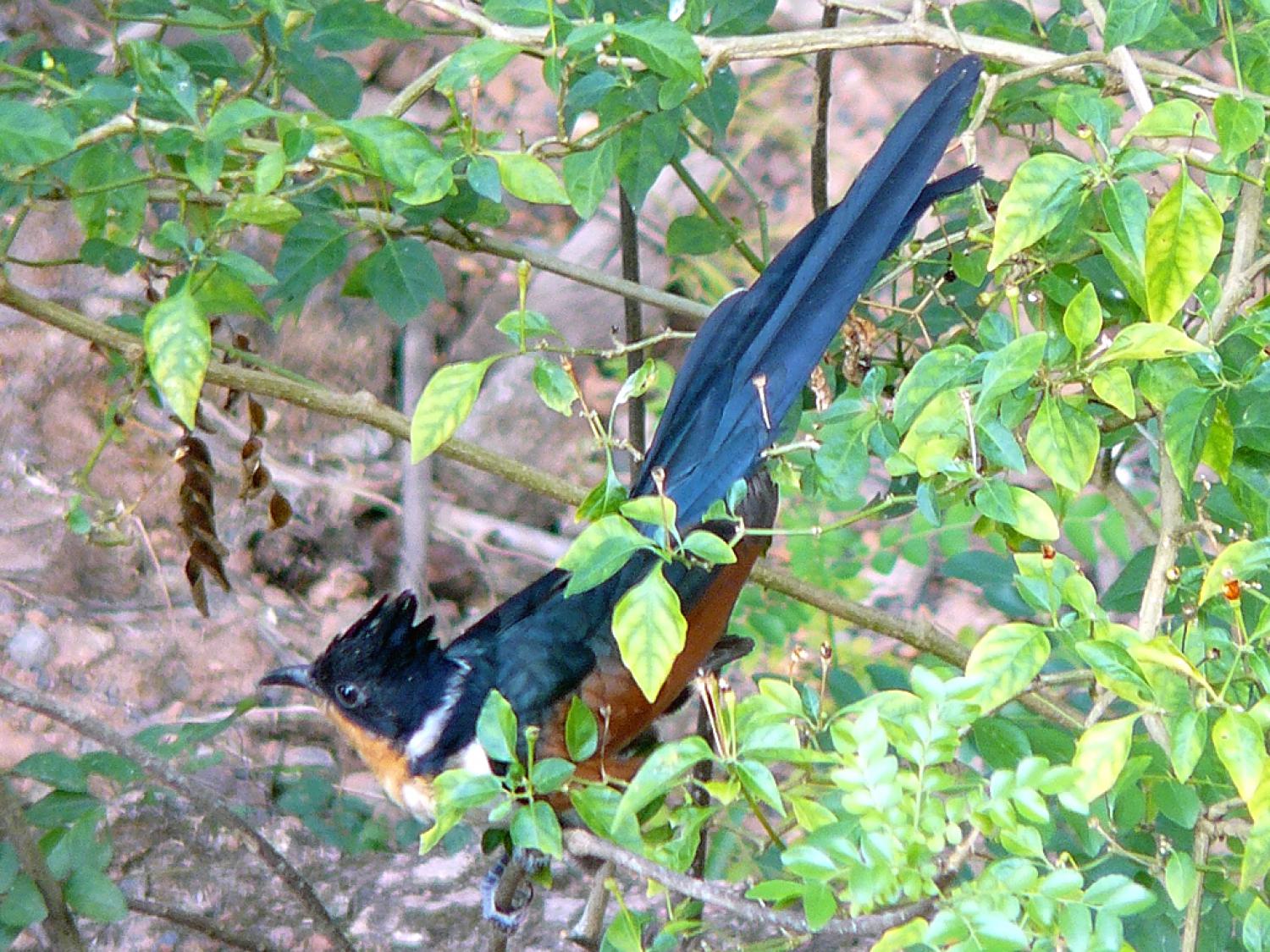Species of Thailand
Chestnut-winged cuckoo
Clamator coromandus
Carolus Linnaeus, 1766
In Thai: นกคัคคูหงอน
The chestnut-winged cuckoo or red-winged crested cuckoo (Clamator coromandus) is a cuckoo found in Southeast Asia and parts of South Asia. It has dark glossy upperparts, a black head with long crest chestnut wings, a long graduated glossy black tail, rufous throat dusky underside and a narrow white nuchal half collar. They breed along the Himalayas and migrate south in winter to Sri Lanka, southern India and tropical Southeast Asia including parts of Indonesia, Thailand and the Philippines. It is about 47 cm long.
Description
This dark and crested cuckoo has chestnut wings, a glossy black crest and a graduated tail (the feathers shortening in steps from the center outwards) whose terminal edges are white and inconspicuous unlike the white tips of the Jacobin cuckoo which is found in parts of its range. The black capping on the head is broken from black of the back by a white collar that extends to the sides of the neck. The lower parts are rufous turning to dark grey towards the vent. Young birds are dusky with a scaly appearance to the wing feathers.
Taxonomy
The species was first given its binomial name by Linnaeus in 1766. His description of what he called Cuculus coromandus was based on the notes of Brisson who described the bird as "Le coucou hupрé de Coromandel" which was collected on the Coromandel coast of India (probably near Pondicherry which was a French colony). Buffon noticed the close relation to the Jacobin cuckoo and called it "le Jacobin huppé de
Coromande". The species was later placed under the genus names of Coccystes, Oxylophus before being placed in Clamator.
Distribution
The species is found from the western Himalayas to the eastern Himalayas and extends into Southeast Asia. It has been recorded from India, Nepal, China, Indonesia, Laos, Bhutan, Bangladesh, Cambodia, Thailand, Myanmar, Malaysia, Vietnam, Sri Lanka and the Philippines. Some populations may be non-migratory.
During migration in India, it moves along the Eastern Ghats in its southward migration with exhausted individuals often being discovered in the vicinity of homes. In mid-October, they are found in numbers at Point Calimere, possibly into Sri Lanka. Some appear to winter in the Western Ghats.
Behaviour
This cuckoo sometimes joins mixed species foraging flocks and is usually seen singly. The breeding season is in summer and it is said to lay its eggs mainly in the nest of Garrulax laughingthrushes, especially G. monileger and G. pectoralis. The eggs are very spherical. The calls include fluty twin-notes repeated with short intervals.
This article uses material from Wikipedia released under the Creative Commons Attribution-Share-Alike Licence 3.0. Eventual photos shown in this page may or may not be from Wikipedia, please see the license details for photos in photo by-lines.
Category / Seasonal Status
Wiki listed status (concerning Thai population): Summer visitor and on passage
BCST Category: Recorded in an apparently wild state within the last 50 years
BCST Seasonal statuses:
- Breeding visitor
- Non-breeding visitor
Scientific classification
- Kingdom
- Animalia
- Phylum
- Chordata
- Class
- Aves
- Order
- Cuculiformes
- Family
- Cuculidae
- Genus
- Clamator
- Species
- Clamator coromandus
Common names
- Thai: นกคัคคูหงอน
Conservation status

Least Concern (IUCN3.1)
Photos
Please help us review the bird photos if wrong ones are used. We can be reached via our contact us page.
Range Map

- Ao Phang-Nga National Park
- Ban Laem District, Phetchaburi
- Bang Len District, Nakhon Pathom
- Bang Phra Non-Hunting Area
- Bang Pu Recreation Centre
- Bangkok Province
- Bueng Boraped Non-Hunting Area
- Chiang Saen District, Chiang Rai
- Doi Inthanon National Park
- Doi Lang
- Doi Pha Hom Pok National Park
- Hala-Bala Wildlife Sanctuary
- Huai Kha Khaeng Wildlife Sanctuary
- Kaeng Krachan District, Phetchaburi
- Kaeng Krachan National Park
- Kamphaeng Saen District, Nakhon Pathom
- Khao Luang National Park
- Khao Phra - Bang Khram Wildlife Sanctuary
- Khao Sam Roi Yot National Park
- Khao Soi Dao Wildlife Sanctuary
- Khao Sok National Park
- Khao Yai National Park
- Khao Yoi District, Phetchaburi
- Khlong Luang District, Pathum Thani
- Khon San District, Chaiyaphum
- Klaeng District, Rayong
- Ko Lanta National Park
- Kromluang Chumphon Wildlife Sanctuary
- Kui Buri National Park
- Mae Wong National Park
- Mueang Chiang Mai District, Chiang Mai
- Mueang Khon Kaen District, Khon Kaen
- Mueang Krabi District, Krabi
- Mueang Nakhon Pathom District, Nakhon Pathom
- Mueang Nonthaburi District, Nonthaburi
- Mueang Phang Nga District, Phang Nga
- Mueang Phetchaburi District, Phetchaburi
- Mueang Samut Sakhon District, Samut Sakhon
- Mueang Suphanburi District, Suphan Buri
- Mueang Surin District, Surin
- Mueang Tak District, Tak
- Nam Nao National Park
- Pai District, Mae Hong Son
- Pak Phanang District, Nakhon Si Thammarat
- Pak Phli District, Nakhon Nayok
- Phu Suan Sai National Park
- Phutthamonthon District, Nakhon Pathom
- Pran Buri Forest Park
- Sai Yok District, Kanchanaburi
- Sakaerat Environmental Research Station
- Salak Pra Wildlife Sanctuary
- Samae San Island
- Samut Prakan Province
- Sirinat National Park
- Sri Phang-nga National Park
- Tha Yang District, Phetchaburi
- Thanyaburi District, Pathum Thani
- Wat Phai Lom & Wat Ampu Wararam Non-Hunting Area
- Yan Ta Khao District, Trang



